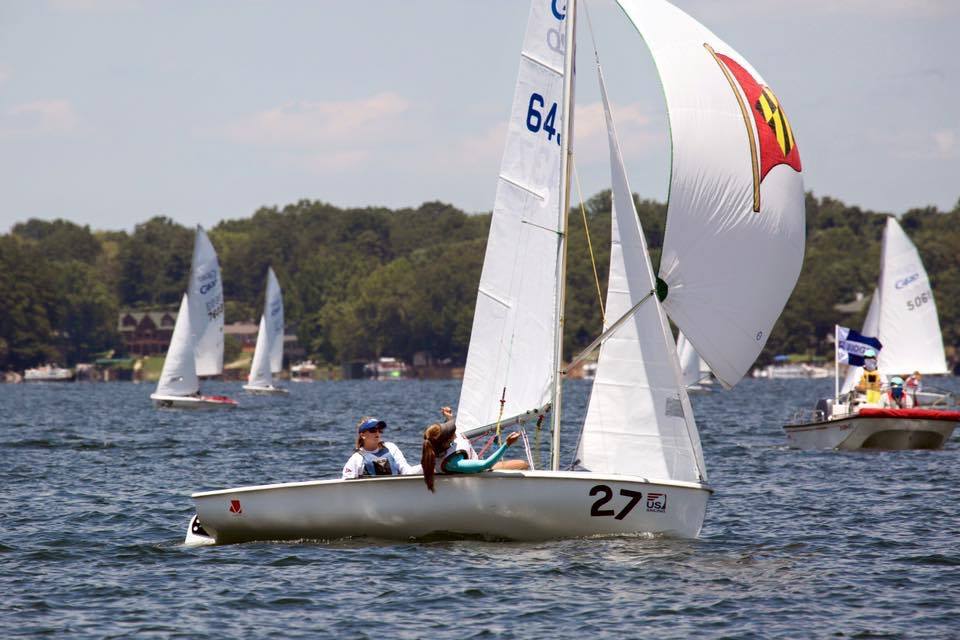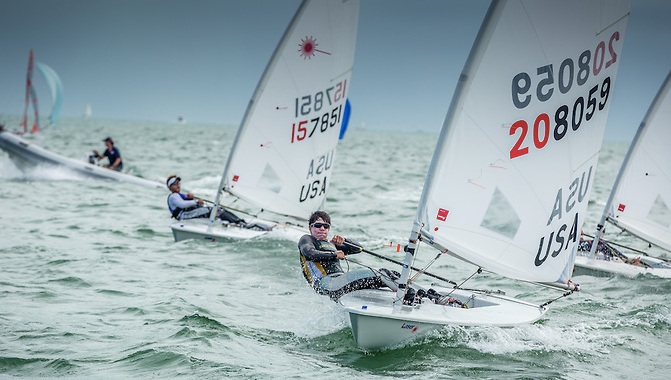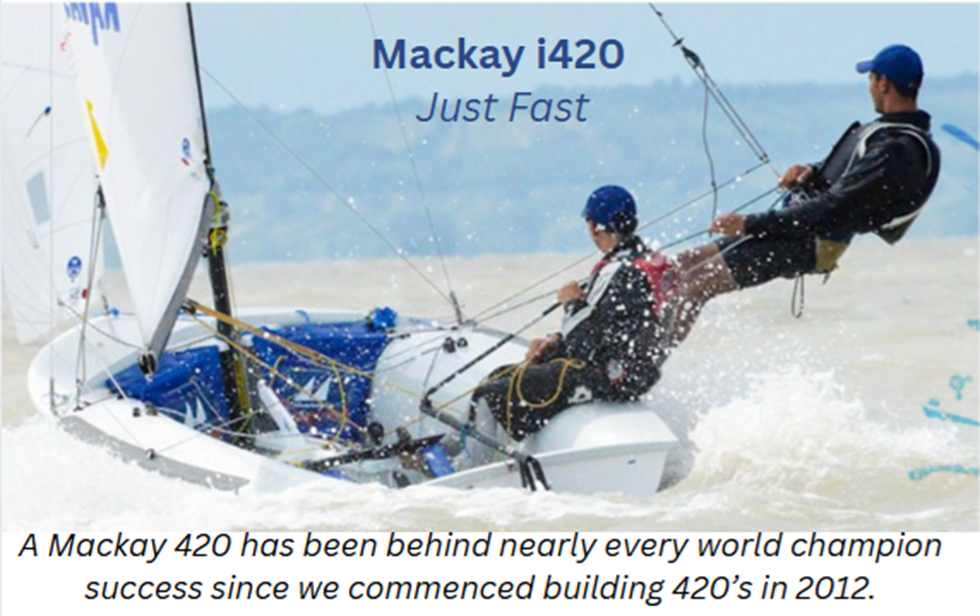By Airwaves Writer Tyler Colvin
The battle of East vs. West sailing has existed for decades with competitors from both coasts seemingly trading podiums with each passing event. Across classes, age ranges and yacht clubs, top sailors from each coast with different approaches dominate the sailing community and skill sets. Harkening back to the hip-hop feuds of the 90s, East vs. West has always been a source of pride and contention amongst competitors in the junior sailing classes, high schools and colleges alike.
In 2015, sailors from the East Coat dominated Opti Nationals with sailors from New Jersey, Annapolis, Florida and Long Island rounding out the Top 5 overall standings. This is a testament to the strength of the East Coat Opti class and the emphasis put on the pram by East Coast clubs.
C420 Nationals showed significantly more parity between the coasts with podium finishes from each. The 2015 C420 Nationals was the largest event in the class history with 196 boats entered. At the Chubb Junior Championships, West Coast teams took the top two spots in the Bemis Trophy as well as a podium spot in the Smythe Trophy.
On the skiff side of things, 2015 29er Nationals were dominated by West Coast teams with 3 of the Top 5 and 7 of the Top 10 teams from the left coat. While admittedly a much smaller fleet size than the other classes, the Olympic class trainer is alive and well on the West Coast.
High school and College sailing around the country is exploding in popularity at the moment. More and more players from varying backgrounds are stepping into boats and never looking back. If junior sailing circuits in Optis and C420s are FJ programs, high school and college fleets are decidedly dirt track run-what-you-brung. Short courses, high volumes of races and no throw outs make high school collegiate sailors competitive and hungry.
Fundamental differences between how high school and college racing are conducted on each coast are a reflection of location and funding. East coast high school and collegiate regattas are primarily held at locations with full fleets; teams show up to a venue, race all weekend, and go home. West coast high school and collegiate teams must travel further distances and provide their own boats either by towing or chartering from hosts. One advantage the West Coast teams have over almost all but the southern East Coast teams is the ability to practice year-round.
Despite the differences in how regattas are conducted on each coast, there is a remarkable amount of parity at the top of the high school sailing world. PCISA schools Point Loma and Newport Harbor are perennial national contenders, but it is hard to count out SAISA contenders Shorecrest and St. Thomas Aquinas, or NESSA’s St. George’s and MASSA’s Annapolis, Severn and Christchurch.
In college sailing it is a slightly different story. East coast colleges dominate the college sailing world with only Stanford as the current west coast contender and Hawaii as a past contender. NEISA and MAISA provide the majority of the top 20 national rankings and top 10 at national championships. Stanford is the lone PCCSC school consistently in the rankings and in the hunt at nationals with Santa Barbara, Santa Clara, Hawaii and USC on the outside looking in.
What the West Coast lacks in tradition and infrastructure to its East Coast counterpart, it makes up for in growth of the sport. In high school sailing PCISA is the fastest growing conference with the numbers of registered teams growing at what seems like an exponential rate. It is a battle of tradition and establishment (East) versus growth and innovation (West). So while the needle may swing towards the East in youth sailing at the moment, don’t count the West out of the picture by any means. At the rate new sailors are growing and improving on the West, it is only a matter of time before the left coast is on equal footing across the board.
Whats your take?
Club Profile: Lake George Club
NewsFlash: The Lake George Club has an opening this summer for a RACE COACH & SAILING INSTRUCTOR!!
The Lake George Club was formally organized and received its certificate of incorporation on November 16, 1908. Nine months later a clubhouse had been built and docks, tennis courts and a nine hole golf course were in place.
The Club opened its doors on August 14th, 1909 with its first and only Superintendent, Mr. Emil Strand and his bride, to welcome the members. Mr. Strand served the members for fifty-four years until he retired in 1963. Each spring he grew the white petunias which graced the Clubhouse. We keep this tradition as a tribute to his long and dedicated service.
The purpose of the Club as outlined in a meeting in 1908 was to provide a place where residents and visitors might meet and have the opportunities for mutual pleasure, to hold regattas and other aquatic sports, to provide a golf course, tennis courts and facilities for other games and make arrangements for dramatic and musical entertainment.
These things were all done, but changes have taken place over the years. The original regattas were motor boat races. Ever faster and more sophisticated boats were built and raced, leading at last to George Reis’ El Lagarto which won the Gold Cup in 1933 and defended the Cup in 1934 and 1935 at the Lake George Club. That was the last Club sponsored motorboat regatta.
Golf was played on a nine-hole course laid out on Club property and property to the north leased from the Marion House. The course ran parallel to and on both sides of the Bolton Road. The Marion House was torn down in 1939 and the land subdivided, but the golf course continued in operation through 1942 when the lease expired.
The original three clay tennis courts served the members for 75 years. For thirty-three of those years, 1916-1949, the Tennis Chair was Miss Helen Simpson, a devoted member who was also a director for twenty-eight years and Vice President for five years. In 1983-84, after ten years of discussion, three new courts were added and the old courts resurfaced. We continue to have some of the finest courts in the area.
Sailing was introduced in 1935 with boats from all over the lake invited to join the eight Club boats; Dr E.F.W. Alexandersons Nordic, Mr. W.M. Bowdens Highland Fling, three Stars and three Cape Cod Knockabouts. The Stars began racing as a separate class in 1936 followed by the Cape Cods in 1937 and the Sound Interclubs in the late thirties. Mr. Harold Pitcairn, who was Commodore from 1940 to 1953, provided his own fleet of two boats in each class sailed by himself and his eight children. Sailboat racing was suspended from 1943 through 1945. New classes were introduced after the war: the Rainbows in 1963, the J-24’s in 1980 and the J-22’s in 1991. The sailing story would not be complete without the mention of Ralph and Mary Derby, Boom Boom and Can Can, who were in charge of the starting guns and signal flags on the race committee boat for over 25 years.
Learn more about our junior sailing program HERE.
During World War II, the membership dropped from 125 to 64. The Club was closed for the 1943 season. A small group headed by C. Everett Bacon, president from 1933-1945, and Hubert Brown, 1946-1947, rallied support and contributions to keep things going. In 1955, the emphasis shifted from the older generation to the baby-boomers.
Tennis, sailing and swimming instructors were hired in 1955 and junior tennis and sailing programs were started. The juniors competed in Turnabouts, Cape Cods and Lasers for the next 25 years. Contributions from the members have permitted the Club to fund three newer fleets: the 420’s in 1979, the Optimist Dinghies in 1990, and the FJ’s in 1994. The children of the baby-boomers are now active participants in our junior programs.
The club presently has 300 regular members and a waiting list of prospective members. The House Committee and staff have revitalized our Social program. Sailing and tennis are actively pursued on all levels.
The Junior Sailing program is a focus of the Club. Juniors grow up sailing, swimming and playing tennis, building long lasting relationships. Their parents and parents did as well. There is a great sense of community and family here! Learn more about the Junior Sailing Program here: http://www.thelakegeorgeclub.com/Summer-Sports/sailing.html
NewsFlash: The Lake George Club has an opening this summer for a RACE COACH & SAILING INSTRUCTOR!!
For more information, please contact:
Tracey Thacker / 518-668-5734 / lgctracey @ yahoo.com
S1D Youth Sailing Team of the Year Award Winners 2015 Announced!
Teamwork. Chemistry. Dedication. Cooperation. Being on the same page as your partner and/or teammates is never easy, especially when that shared vision has to endure, and not simply be a statement of purpose on the dock. These characteristics are requirement in youth sailing team success. Sail1Design is proud to recognize the top North American Youth Sailing Team, each year, with this prestigious award.
The award is presented annually, in January, and reflects the efforts of a youth sailing team throughout that previous calendar year. This is YOUR award! We require written submissions of nomination; in fact we only choose from nominated sailors, and do not suggest nor solicit specific nominations. If you’d like to nominate a team, please write a 200 word minimum letter, with regatta results, to [email protected].

Please enjoy reading excerpts from our three nominating letters:
Nomination letter #1 I would like to nominate Stephanie Houck and Camille White for the 2015 Youth Sailing Team of the Year award. These two young ladies have put in a tremendous amount of work and energy into their sailing this year. When I first met them, Stephanie and Camille were sitting on a couch in my office trying to work through some skipper crew communication issues. They were smart enough to realize a major problem before it happened and sought help to come to a healthy solution. Less than a year later, with lots of practice and help from many coaches, Stephanie and Camille won the Ida Lewis regatta. This was a huge accomplishment for the both of them and it made them work even harder to stay at the top of their game and the top of the C420 circuit. After another month and more rigorous training, this duo won top female honors, top junior boat, and 1st place overall at the largest ever Club 420 National Championship. As a young team, there is plenty of time left for these two to continue to develop and get even better.
Nomination letter #2 I write to nominate Stephanie Houck/Camille White to be designated as Sail1 Design’s 2015 Youth Sailing Team of the Year. Here are my reasons.
- In June, Stephanie and Camille did not just win the US Sailing Jr. Women’s Double-handed Championship (aka the Ida Lewis Trophy), they dominated the 39 boat fleet. Over the ten races completed, they had five bullets, two seconds, two thirds, a fourth and a fifth (that was their drop) and won with 16 points, an average finish of 1.77. They did not need to sail the last race, but of course, did.
- Roughly three weeks later, Stephanie and Camille won the 2015 Club 420 National Championship at Sail Newport. One hundred ninety-four teams raced in the event which is, I believe, the largest double-handed one-deign regatta in the US and probably the most competitive fleet this summer as it included, amongst the 193 other teams, skipper Ivan Shestopalov, winner of an IODA South American Championship and 2nd in an IODA North American Championship. They were only team with all single digit finishes!
I do not recall another all women boat winning the Club420 national championship. Perhaps even more impressive they were “Club 420 juniors” at the time, that is not turning 17 before 12/31/15.
I note that your criteria are as follows;
Teamwork. Chemistry. Dedication. Cooperation. Being on the same page as your partner and/or teammates is never easy, especially when that shared vision has to endure, and not simply be a statement of purpose on the dock. These characteristics are requirement in youth sailing team success.
These results are not by accident nor attributable to the skipper or the crew. These results at this age reflect a lot of hard training in the spring and early summer and more importantly, a willingness to work together and listen to each other. I think it is pretty clear that these were championships won by “Stephanie/Camille.”
Nomination letter #3 Stephanie Houck, 16, and Camille White, 15, from Annapolis, MD, began sailing together in the Club 420 in 2014. Stephanie, a year older than Camille, crewed in the Summer of 2013 for Julia Lambert; Camille joined Stephanie directly from the Optimist dinghy class. Stephanie and Camille had been close friends even before they started racing Opti’s in the Green Fleet, as they would tag along to the regattas of their older siblings. They definitely had friendship and chemistry off the water, but had never sailed together as a team.
In preparation for their first summer racing together, Stephanie and Camille attended clinics including the 2013 Warm Up Clinic Pre-Orange Bowl, 2014 CISA Advanced Racing Clinic, and the 2014 Neill Advanced Sailing Clinic. They also competed together throughout the summer of 2014 on the Chesapeake Bay as well as in New England.
In 2014, Stephanie and Camille’s results were not particularly impressive, and they even overcame some rather embarrassing experiences. For example, at the 2014 C420 North American Championship in Brant Beach, NJ the breeze picked up to 20-25 kts. In big breeze, due to their inexperience, the girls spent a lot of time “upside-down.” Unfortunately, it was so shallow on Barnegat Bay that in addition to their mast getting stuck in the mud, their boom did too! After racing that day, they spent over an hour washing their sails and cleaning out the mud inside the mast, but they didn’t get it all. The next day, a ton of muddy water was dripping out of the boom and getting all over Camille; huge chunks of mud remained lodged inside. Stephanie’s idea was to stick the spinnaker pole in the end of the boom to try to get the mud out, but then the pole got stuck in the boom! Meanwhile, the Race Committee blew the warning signal, Camille was absolutely covered in mud, and Stephanie was frantically trying to get the spin pole out of the boom! Luckily they sorted it out before the start. They still laugh about all the funny looks they received from fellow competitors!
Stephanie and Camille didn’t give up and continued to work hard, and in 2015 their dedication produced amazing results, as referenced above. As a team, they both improved in communication, boat handling, and in making tactical decisions. Stephanie credits Camille as an amazing crew who is extremely athletic and is able to learn new things incredibly quickly. Camille is always adjusting things to make sure their sail shape is perfect, and Camille is great at communicating pressure, shifts, etc. Often interaction between skipper and crew can complicate a relationship off the water, but Stephanie and Camille have actually become even closer friends thanks to sailing.
For any team to win a single national championship such as the Ida Lewis in a given year is tremendous; but winning two national championships is extremely rare. And, 2015 Club 420 Nationals was the largest Club 420 regatta ever held! Finally, Stephanie and Camille were the first ever all girls team to win Club 420 Nationals. This victory in particular is outstanding for women’s sailing, and the future of the sport. This proves that girls can compete and beat the boys!
2015 Regatta Results
US Sailing Junior Women’s Doublehanded Championship (Ida Lewis Trophy), Columbia Yacht Club, SC.
o 1st Place (39 boats)
Club 420 Association National Championship, Sail Newport, RI
o 1st Place (196 boats)
o Top Girls Team
o Top Junior Team (16 years old or younger)
Brooke E. Gonzalez Advanced Racing Clinic Regatta
o 3rd Place (20 boats)
Learn more about our S1D Youth Sailing Team of the Year
S1D Optimist Sailor of the Year Award Winner 2015: Luke Arnone
Sail1Design is elated to announce our very first winner of the S1D Optimist Sailor of the Year Award winner, Luke Arnone!
Optimist sailing, for so many, is where it all starts. In fact, there may be no healthier one-design class in North America than the US Optimist Class. Sail1Design is proud to salute this boat, the people involved in the class, but most importantly, the kids who get out there in sail in this great little boat. This is the Lone Wolf in training, the next great singlehanded sailor!
This award, announced each January, goes to the Optimist sailor, who in the evaluation of our judge panel (from nominated sailors), had the best overall sailing year, for the preceding calendar year. This is YOUR award! We require written submissions of nomination; in fact we only choose from nominated sailors, and do not suggest nor solicit specific nominations. If you’d like to nominate an Optimist sailor, please write a 200 word minimum letter, with regatta results, to [email protected].
The S1D panel was certainly impressed with Luke’s race record; however we were even more impressed with his sportsmanship, hard work, and the fact that he is well-liked and respected by his peers and competitors. This is a great recipe for long term success, in any endeavor, and we are very proud to have Luke win this award!! Read below from the nomination letter, to learn a bit more about Luke:
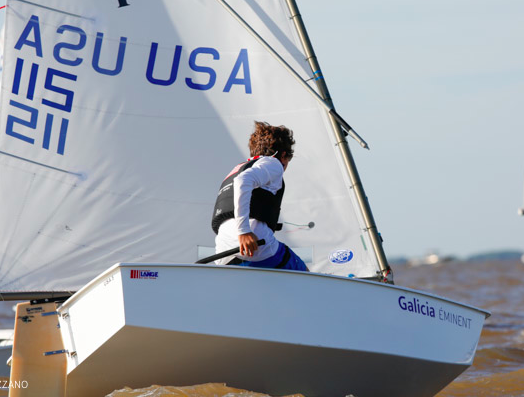
Luke Arnone is 14 years old and from Mantoloking, NJ. He sails for Mantoloking Yacht Club and CERT (Colie Elite Racing Team). He is a 9th grade student at Ranney and has just helped to start a sailing team at his high school.
Luke’s Opti results are second to none, and he has showed that he can be at the top of the fleet in any breeze, any condition, and on any day. Highlights this year include first place at the Optimist Team Trials (qualifying for the Optimist Worlds for the second time) and winning the Optimist Nationals. Most importantly, Luke is a hard worker, his peers and competitors respect him, and he is a good sport. His work ethic and his understanding of the game continue to impress me.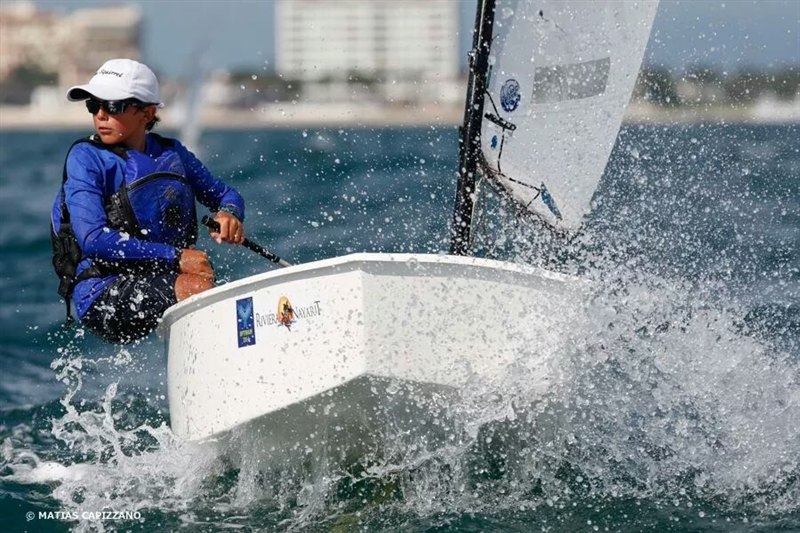
TR Midwinters; New Orleans, LA: 1st Place
USNT Practice; Miami, FL: Top Gun Award
Florida State Opti Champs; Jenson Beach, FL; 1st Place
Lake Garda International Optimist Meeting; Lake Garda, Italy; 8th Place (900+ boats)
SE Dinghy Champs; Key Biscayne, FL; 3rd Place
US Team Trials: Miami, FL; 1st Place
Volvo Ocean Race Team Race Regatta; Newport, RI; 1st Place
North American Champs; Antigua; 12th Place
North American Team Racing Champs; Antigua; 1st Place
US National Champs; Pensacola, FL; 1st Place
US National Team Racing Champs; Pensacola, FL; 3rd Place
New Jersey Opti Champs; Surf City, NJ; 2nd Place
World Championship; Poland; 24th Place

Learn more about the S1D Optimist Sailor of the Year Award
S1D Youth Sailor of the Year Award Winner 2015: Caden Scheiblauer
Presented by KO SAILING
Sail1Design and KO Sailing are elated to announce the first winner of the Annual Sail1Design Youth Sailor of the Year “Lone Wolf” Award. Dedication. Perseverance. Independence. These are just some of the attributes of the go-it-alone sailor, the lone wolf who is able to train, plan, and compete by her or himself, and do it successfully. This award, presented by KO Sailing, goes to the North American youth sailor who best personifies the qualities necessary to be a successful athlete in the single-handed sailing world. Sail1Design picks ONLY from nominated sailors… this is YOUR award!!
Mark McNamara of KO Sailing noted: “KO Sailing congratulates the winner of this year’s award. Our mission is to support sailors in their efforts to rise to the next level. The S1D Youth Sailor of the Year Award is the perfect vehicle to recognize the efforts of these sailors as they achieve their goals. Our Sponsorship of the S1D awards is a small return for the investment these sailors make and we are proud to be a part of it.”
The Sail1Design staff was most impressed with this nomination letter, among all others, especially with Caden’s dedication and commitment to improve.
Here is the nomination letter for Caden:
I would like to nominate Caden Scheiblauer, from Santa Barbara, CA and representing Santa Barbara Yacht Club and the Santa Barbara Youth Sailing Foundation for the “Lone Wolf” Award: Sail1Design Youth Sailor of the Year.
Caden epitomizes the definition of the “Lone Wolf” Award; he is a Laser Radial sailor. Caden first sailed competitively in Optimists at the age of 10 years old. By the time he was 12 he was too big for the boat and transitioned into the Laser Radial when many of his contemporaries were still sailing Optimists. Many of his older sailor friends were sailing 29ers as they were not big enough to sail a Radial.
Caden took to the Laser Radial immediately and loved the feeling of a faster, more powerful boat. He has been sailing the Radial for 2 years.
Sail1Design uses the words dedication, perseverance, and independence to define the “Lone Wolf” recipient. At 135 pounds and 12 years old when he began sailing the Laser Radial, Caden knew that he needed to differentiate himself through fitness, diet and exercise to compete in breezy conditions with the older, bigger kids already sailing Lasers. He did not let the fact that many of the kids he had grown up sailing around were no longer in his fleet; he was a lone wolf.
Fast forward to 2015 and I believe that Caden’s enthusiasm and dedication are paramount to his current success in the Laser Radial. Caden is a lean 147 pounds and 5 feet 10 inches tall. He started an intense workout routine going to gym 4 times a week in late 2014 and has continued in since. He routinely gets up before school to work out or will go after he completes his homework and will not skip a workout. In addition he does not eat red meat, and adheres to a strict no sugar, high protein and complex carbohydrate diet. You won’t find a 14 year old as dedicated to the sport and his fitness as Caden.
In the summer of 2015 he competed in numerous high profile Laser events and some of his accomplishments are below;
13th Cressy Trophy – 18 competitors(only freshman in the competition)
2nd PCISA Cressy Eliminations – 31 competitors(only freshman to qualify)
4th – Laser District 25 Champs/Frost #1 – 40 competitors
22nd Laser North Americans -115 competitors
14th Laser US Nationals – 127 competitors
2nd Junior Olympics – 25 competitors
3rd Laser Pacific Coast Champs(PCC’s) – 34 competitors
4th ABYC Olympic Classes Regatta – 32 competitors
3rd ABYC Memorial Day Regatta – 16 competitors
5th Laser Gulf Coast Champs – 33 competitors
14th Laser Midwinter’s West – 51 competitors
30th Laser Midwinter’s East – 118 competitors
Most recently Caden has been invited to participate in the US Sailing Olympic Development Program Camps sailing with coaches Leandro Spina, Anna Tunnicliffe, Rulo Borojovich. Caden understands the importance of his fitness in the Laser Radial class and has increased his commitment to this aspect by signing on with Anna Tunnicliffe and works out 4 times per week with CrossFit style sailing workouts.
To culminate a fabulous 2015 Caden was invited to travel to the Australian Laser National Championships outside of Sydney, Australia on Dec. 26th at Belmont 16’s Sailing Club. He will be working with US Sailings Olympic coach Mark Littlejohn and relishes the opportunity to represent the USA at this event.
I do not think you will find a more dedicated 14 year old to his sport. Caden wishes to represent the USA in the Laser in the 2024 Olympics. You can follow him on his website he singlehandedly composed and launched at www.cadenscheiblauersailing.com. For all the dedication, perserverance and independence I have described in his diet, workouts, training and traveling to regattas, I believe Caden is a worthy recipient of the Lone Wolf award. In addition he maintains a 4.0+ grade point average at Santa Barbara High School.
Learn more about our Youth Sailor of the Year Award.
Club Profile: Nantucket Yacht Club
The organization which was to become the Nantucket Yacht Club was first chartered in 1890 as the Nantucket Athletic Club. By the summer of 1906 a second group had come together, calling themselves the Nantucket Yacht Club, whose purpose was to provide sailing and racing for the summer residents of Nantucket, their families and friends. The leadership and membership have been able to hold a steady course – no easy matter with a seasonal operation – making changes as conditions have required and proving that yacht racing and sailing, tennis and social activity can all be kept lively and popular. The next hundred years will be exciting and are full of great promise.
Into a burgeoning summer scene, the Nantucket Yacht Club was born in the summer of 1906, when sailing enthusiasts led by H. Holton Wood assembled their boats off Brant Point and held organized races in Nantucket Sound. They met in houses built on Hulbert Avenue in 1900 by Henry Oliver Underwood, and had use of a nearby pier, complete with gazebo, owned by the neighboring Atkins Family. Although still in its infancy, the new club acted as though it had been established for years. The first flag officers were H. Holton Wood, commodore; J.E.T. Rutter, vice commodore; Alice Underwood, secretary-treasurer; and Margaret Underwood, fleet captain. In mid-September, the yacht club held its first Commodore’s Cup Race to close the season. The new club was here to stay. Like no other instuition of Nantucket, it is a place where traditions are honored, where the past is respected, and where families are celebrated – its history intertwined with that of the island it calls home.
Sail Stronger, Part II: The Legs
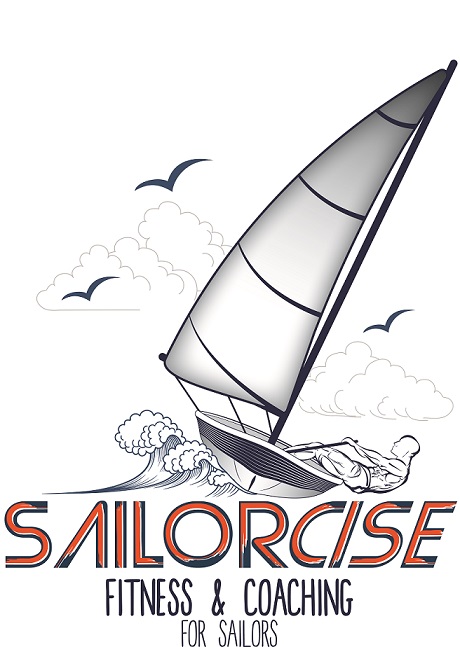
See Part I: The Core here
Part III: The Arms here
In Part One, The Core, we learned last that strength in certain muscles in our bodies are more important then others. We determined that strength in our core, legs, and arm muscles are essential to maximizing our performance on the water. In Part One we talked about the core and how it is the base of sailing stronger. Without a strong core your body will move inefficiently and can eventually lead to injury. In Part Two we will be talking about the importance of strength in your legs and different exercises to help you in this area.
Your legs are a very large muscle group in your body and essential for mobility. Some of the major muscles in the legs are the hamstrings (back of the thigh), adductors (inner thigh), quadriceps (front of the thigh), and the calf muscles (gastrocnemius and soleus). Having strong legs is an important part of being a top athlete. A problem we see sometimes is people training their arms, but completely forgetting their legs. Power comes from your legs so its important to strength train them for the best performance. Leg exercises also increase core stability and therefore this increases strength and stability throughout your body.
So now that you know the benefits of leg strength, why is it important in sailing? When you are out hiking your legs are essential for your success to keep the boat flat. With strong legs you will have the endurance to keep hiking on long windy days. Your legs are also needed for your mobility on the boat. With strong legs you will have the speed to move quickly when needed. Ever auto-tacked before? Well with strong legs your will be able to react to that more quickly and get to the other side of the boat better then someone who doesn’t have strength in their legs.
Now that we know why leg strength is so important to sailing, lets get strong legs! There is many different leg exercises out there. I have picked four that I think are the best for strengthening your legs for sailing.
- Wall Sits – With these you will feel the burn in your legs! This is a great exercise to give your legs the endurance to sail longer. To do this exercise stand with your back against the wall and with your feet in front of you hip distance apart. Slide your back down until your at a 90 degree angle. Hold for 30 seconds to start then work yourself up to 1 minute.
- Squat Jumps – These are a great exercise to not only work your legs, but total body. This exercise will really get your heart pumping. Stand with your feet shoulder width apart. Squat down as you are doing a normal squat, then engage your core and jump into the air. Land back in squat position and repeat. Start with doing this exercise for 30 seconds then work up to doing for 1 minute.
- Weighted Lunges – Lunges are a great workout for your legs. Adding weights is a great way to add some resistance to help strengthen your legs even more. For these grab weights that you feel comfortable with and you won’t compromise your form. 8-10 pound weights are a great starting point. Stand with dumbbells at your sides. Step with your right foot forward and lower your body into a lunge. Step back and repeat with the left side. Continue to alternate sides. Begin with doing this exercise for 30 seconds and working up to 1 minute.
- Single Leg Squats – Squats are a great leg exercise and there are many different variations. Single leg squats will not only strengthen your legs, but engage your core improving your balance. Stand with your arms extended in front of you. Standing one one leg with your other leg extended straight out in front of you squat down. Try to squat down as far as possible without compromising your form. Repeat move, start with 30 second and work up to 1 minute. (Note: If you find these to difficult start with regular squats and work your way up to single leg squats.)
(You can easily make these exercises into a leg workout. Do 3 sets of each exercise for 30 seconds to 1 minute with a 15-30 second break between each set.)
-Check out the video of these exercises below
Strong legs are another key component of sailing longer and stronger. With them you will be able to move more quickly and efficiently while sailing and not fatigue quickly on those long windy days. These exercises will give you a start to having strength in your legs to help you sail longer and stronger. Now you know that a strong core is the base of your overall fitness and your legs will give you the power and endurance you need to maximize your performance on the water. In part three our final of the series we will learn about strengthening your arms for better performance on the water.
For more information on fitness for sailing contact [email protected]. Also check out Sailorcise on Facebook, Twitter, and Instagram for daily tips on fitness, nutrition, and sailing.
2015 Orange Bowl Regatta Results
Overall OPTIMIST RWB
Optimist Green Fleet
Overall Club 420
Laser FULL RIG
Laser RADIAL
Laser 4.7
Club 420 Sailing Association on Inclusion and the Malaysia World Youth Championship

President of the Association, John Morgan, says “our Board of Directors has opted to set an example, as well as attempt to lessen the damage this has done to youth sailing and sailing in general. We want to reinforce the belief that all athletic competition should be open and unaffected by politics. Many youth regattas including those sanctioned by the Club 420 Association showcase the values intended for this sport, offering a highly competitive, fun, diverse environment that reflect the true spirit of the sport.”
Details of the Club 420 Association offer will be finalized upon discussion with Israeli and Malaysian Sailing as the Association will work to provide some of the financial support for the sailors and teams who wish to attend.
About The Club 420 Class Association The Club 420 Association was established in 1980 to promote, foster, encourage and sponsor one-design sailing. The Association sponsors a class North American Championship, US and Canadian National Championships as well as regional championships for the class across North America while promoting the class to all ability and experience levels of youth sailing. Since 2006, the class membership has more than doubled from 300 to its current 715 members. The class offers many regional, national and North American championships in both fleet and team racing formats as well as clinics across North America. Our Nationals / North Americans have had 175 boats attend, with all levels of sailors competing in some of the finest and socially fun regattas you will attend.
About The Club 420 The Club 420 is a two person dinghy which forms the base of many local, high school and collegiate programs in North America. Simple for beginning sailors and yet challenging enough for collegiate champions. The Club 420 offers more learning opportunities than any other double-handed boat you can find. Over 5,000 Club 420s are sailed in youth, high school and collegiate programs all over the United States, Canada, Mexico and the Caribbean.
For more information please visit our website at www.club420.org or visit us on Facebook
Contact:
John Vandemoer, Executive Director Email – [email protected]
Win a J/22, and Support GBSA!!
The Need
Sailors know instinctually that sailing is a lot more than a sport, especially to a kid. Sailing develops character, self reliance, problem solving skills, confidence and teaches discipline, teamwork and respect for our environment. GBSA‘s mission is to give that experience to as many as possible.

Back in 2014 we were the first to try a crazy stunt – Buy a J/70 and raffle it off to raise money. It worked and now we’re doing it again with a brand new 2016 J/22 built by USWatercraft.
The Rules
Only 650 tickets will be sold – so your odds of winning are way better than winning powerball! In addition, you’re supporting the future of the sport you love – so what are you waiting for?!!…
GBSA Makes a Difference
“The best part was from day one, it was sailing time. Get out and sail. He came home everyday excited to tell us what he learned and the fun antics the crew had together. We look forward to next year and supporting anyway we can”
We Need Your Help
The fact is we can’t do this alone – we need you to help promote this in order for it to succeed. Like us on Facebook, share it with your friends, your yacht club, buy a raffle ticket.
Club Profile: Hudson River Community Sailing is Hiring!
Hudson River Community Sailing develops leadership and academic success in underserved New York City youth through sailing education and provides maritime education and recreation to the community at large.
Hudson River Community Sailing is hiring a Sailing Instructor
For more opportunities, click HERE
Founded in 2007 to serve the urban community, we partner with public schools to offer credit-bearing academic programs, internships, mentoring, and college readiness. Our youth development platform uses sailing, boat operation, and boat building to further academic skills and instill the qualities of character necessary for college and career success. We also serve the broader community through affordable marine education and recreation for individuals, groups, schools, businesses, and families.
“Although I have learned so much about sailing, this program also greatly improved my social skills. I have become much more open, I have become a better leader, and most importantly I learned how to teach others the skills I have acquired. I did not immediately notice the changes occurring until the people around me commented on how much of a positive impact sailing and being part of this program had on me.” -Anthony, Youth Program Graduate (Oakcliff Scholarship Winner)
Find Our Boathouse VIEW ON MAP
Hudson River Community Sailing
West 26th Street & 12th Avenue Pier 66
Boathouse inside Hudson River Park
New York, NY 10001
Sail Stronger, Part I: The Core
By Airwaves writer Rachel Bennung
Editor’s Note: Sail1Design is thrilled to introduce Rachel Bennung, our newest Airwaves writer and member of the Sail1Design team. Rachel is not only an experienced sailor, but she’s also a fitness expert; someone who practices what she preaches! We hope you find these articles helpful, and we also hope they inspire you to improve your sailing by making fitness an integral part of your sailing regimen. Sail1Design now has a new main menu bar category, Sailing Fitness, dedicated to helping sailors reach their athletic potential.
See Part II: The Legs here
Part III: The Arms here
In every sport different muscle groups are more important then others to help maximize your performance in that specific sport. You want strength in your total body, however, you want to focus a little more on strengthening specific muscle groups you will be using more often. In sailing three main muscles groups you are always working are your core, legs, and arms. In this three parts series we will talk about the importance of strength in these areas for sailing, and different exercises to help strengthen these areas.
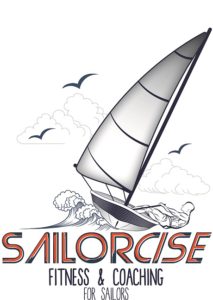
- Planks – These are one of the best exercises out there to strengthen your core. This exercise you begin on your forearms and toes on the floor. You want to keep your body in a straight line. Start with holding this position for 30 seconds and work up to 1 minute. As your core becomes stronger you will be able to hold this position for longer.
- Spider Plank – A spider plank is another great exercise adding movement to help strengthen your core. You start in plank position with you hands and toes on the floor. While in plank you bring your knee up to you elbow and alternate sides. Start with 30 seconds and work your way up to 1 minute.
- Superman – With this exercise you will lie on your stomach with your arms and legs full extended. At the same time raise your arms, legs, and chest off the floor and hold the contraction for 2-5 seconds. After the contraction lower to the ground and repeat. Start with doing this move for 30 seconds then getting up to 1 minute.
- Russian Twist – This move can also be know as mason twist, or oblique twist. Sit on the floor with your knees bent and raise your feet off the floor. Clasp your hands together and turn your body all the way to the right side then over to the left side. Start with doing this move for 30 seconds and working up to 1 minute. You can hold a medicine ball to add resistance.
(You can easily make these exercises into a core workout. Do 3 sets of each exercise for 30 seconds to 1 minute with a 15-30 second break between each set.)
-Check out the video of these exercises below
Having a strong core is the base of sailing stronger. Without the core your body will move inefficiently and can eventually lead to injury. A strong core is the first step to helping to improve and maximize your performance on the water. These four exercises will help to start you on your way to getting that strong core you need and want! Part two of the three part series we will talk about strengthening your legs.
For more information on fitness for sailing contact [email protected]. Also check out Sailorcise on Facebook, Twitter, and Instagram for daily tips on fitness, nutrition, and sailing.
Check out Sail Stronger, Part II: The Legs





